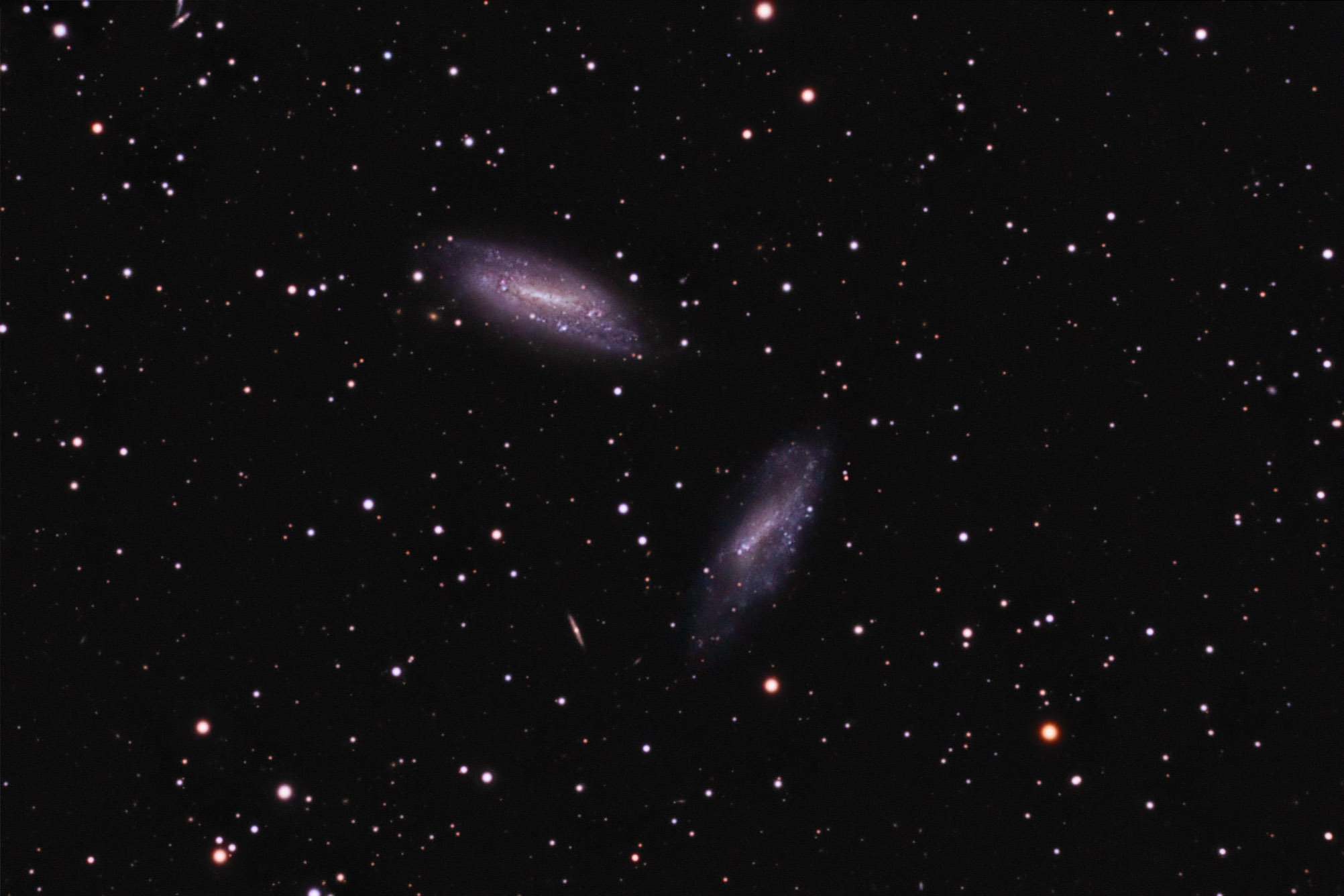Object name: NGC672Designation(s): NGC672, IC1727, NGC 672/UGC 1256 (north left of center) and IC 1727/UGC 1249 are an interesting, nearby, pair of galaxies in Triangulum. The red-shift distances are highly unreliable saying they are only 7 and 3 million light-years away respectively. This can't be true. Other distance measurements at NED put the distance to NGC 672 in the range of 23 to 32 million light-years and that of IC 1724 between 21 and 23 million light-years. Adam Block while at NOAO put the distance to both at 18 million light-years which is the distance cited in the paper quoted below though it gives 15 million light-years for IC 1727. Most sources consider them as interacting so the true distance to both should be close to the same. Radio measurements show the HI clouds around these two galaxies to be contiguous, not just overlapping. I found this interesting note at NED:
"UGC 1256 In this SB(s)cd spiral companion of UGC 1249, the HII regions are arranged along a bar in the inner parts and seem to draw a weak spiral structure around it. For this late type galaxy, no clear nucleus can be seen on the continuum map which shows several knots in the central part. The rotation curve, like that of its neighbor UGC 1249, is irregular, notably in the inner parts where it shows a counter-rotation motion. Indeed, one can see an inversion of the sign of the velocities within 20 arcsec of the center, corresponding to two HII regions (that surrounded by the isovelocity 420 and that on its right), with a symmetric behaviour for both sides of the rotation curve. The center of rotation has been chosen in order to have the two sides of the rotation curve symmetrical, but we want to underline the fact that this peculiar motion of counter-rotation persists if we choose another knot as the center, showing that this motion is real. The curve begins to be fairly symmetric beyond 100 arcsec (3.9 kpc), seeming to reach a plateau around 80 km s^-1^. However, according to the HI data, the plateau could be around 120 km s^-1^. Unlike what Carozzi-Meysonnier (1982) claimed (namely that UGC 1256 was less affected by the interaction according to optical studies), it is hard to estimate which galaxy is the more perturbed. Concerning its content in atomic hydrogen, the WHISP data show that its column density is very high in the optical disk (more than 20 x 10^20^ atoms cm^-2^), and that there is an extension of neutral gas to the north of the galaxy, which could be a tidal tail due to the interaction."
NGC 672 was discovered by William Herschel on October 26, 1786. It is in the second H400 observing program. Unfortunately my log for that never made the move to Minnesota for some reason.
For IC 1727 it says:
"This SB(s)m galaxy exhibits an asymmetric structure on the DSS image also observed on the Ha emission, which is mainly localized in what looks like a central bar and on the north-west side, suggesting a distorted spiral arm. No clear nucleus was detected on the continuum map and the center of rotation was chosen in order to derive the most regular and symmetric rotation curve possible. This rotation curve is quite chaotic but it seems that (from the approaching side) we reach a plateau at 70 km s-1 beyond 130 arcsec (2.8 kpc). About 9 arcmin to the north-east, UGC 1249 has a companion, UGC 1256, with which it seems to be interacting. Indeed, on the HI map derived by WHISP, one can see that their HI disks are contiguous and their velocity fields are regular and show a continuity in the isovelocity lines. The amplitude of the HI velocity field is in agreement with that derived by GHASP, confirming that we reach a plateau on the approaching side. "
http://adsabs.harvard.edu/cgi-bin/bib_query?2003A%26A...399...51G
IC 1727 was discovered by Isaac Roberts on November 29, 1896.
Only three other galaxies in the frame have redshift data and one of those is nearly off the frame. The pair of galaxies along the north edge toward the left corner are CGCG 482-017 at about 480 million light-years. The remaining galaxy is also at 480 million light-years. It is very small and faint. For those who want to track it down it is at pixel 123x954 near the left edge below center. The only "bright" galaxy in the image beside NGC 672 and IC 1727 is LEDA 1803573. It is the orange spindle just east (left) of the south end of IC 1727. NED had no redshift data for it. It is obviously a background galaxy.
14" LX200R @ f/10, L=4x10' RGB=2x10'x3, STL-11000XM, Paramount ME Related Designation(s):11HUGS 033, 11HUGS 034, 2MASS J01475449+2725579, 2MASX J01472988+2720000, 2MASX J01475452+2725580, 2MASXi J0147306+271952, 2MASXi J0147535+272559, 2MFGC 01346, ADBS J014729+2719, ALFALFA 2-168, ALFALFA 2-169, CGCG 0144.6+2705, CGCG 0145.0+2711, CGCG 482-014, CGCG 482-016, HI J014729.9+271958, HI J014753.9+272555, HOLM 046A, HOLM 046B, IC 1727, IC1727, IRAS 01446+2705, IRAS 01450+2710, IRAS F01446+2704, IRAS F01450+2710, KPG 040A, KPG 040B, KTG 08A, KTG 08B, KUG 0144+271 NED01, KUG 0144+271 NED02, LCSB L0071O, LDCE 0160 NED002, MCG +04-05-009, MCG +04-05-011, NGC 0672, NGC672, NSA 130396, NSA 169779, NVSS J014756+272617, PGC 006574, PGC 006595, SSTSL2 J014729.89+272002.1, UGC 01249, UGC 01256, UZC J014731.3+271939, UZC J014754.3+272559, VV 338a, VV 338b, [M98j] 026 NED01, [M98j] 026 NED02, | | 